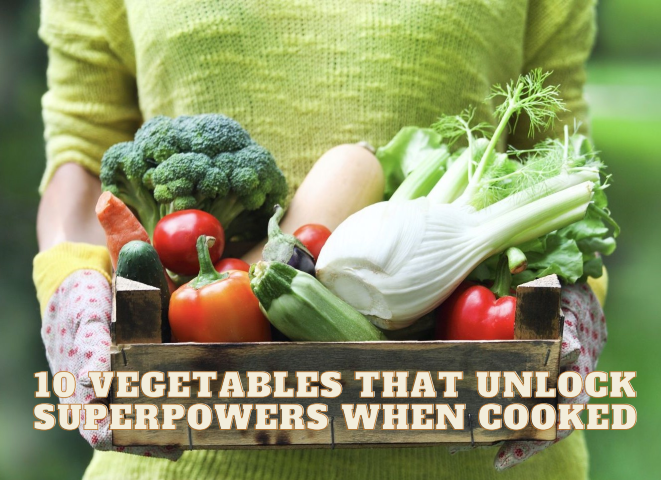
Beyond Rawesome: 10 Vegetables That Unlock Superpowers When Cooked
Share
by Ken Lain, the mountain gardener


While the raw food movement has gained popularity, certain vegetables become more nutritious when cooked. The heat from cooking breaks down rigid cell walls, making it easier for our bodies to absorb essential nutrients. Cooking neutralizes harmful compounds and enhances certain vegetables' flavors and textures. Here will explore ten healthier cooked vegetables and provide tips on preparing them to maximize their nutritional benefits.

Asparagus is rich in vitamins, minerals, and fiber. However, it also contains a tough fibrous compound called lignin, which is difficult for the body to digest. Cooking asparagus breaks down lignin, making it easier to digest and absorb nutrients. Roasting, grilling, or steaming asparagus are all great ways to enjoy this delicious and nutritious vegetable.

Beans are a nutritional powerhouse packed with protein, fiber, vitamins, and minerals. However, raw or undercooked beans contain lectins, which cause digestive problems. Cooking beans thoroughly neutralizes lectins and makes them safe and easy to digest. Soaking beans overnight before cooking further reduce lectin levels and shorten cooking time.

Broccoli is a cruciferous vegetable rich in vitamins, minerals, and antioxidants. Cooking broccoli increases the availability of certain nutrients, such as sulforaphane, a compound linked to cancer prevention. However, overcooking broccoli destroys some of its nutrients, so it is important to cook it until it is tender-crisp. Steaming or stir-frying are suitable cooking methods for preserving broccoli's nutrients.

Carrots are packed with beta-carotene, a precursor to vitamin A, which is essential for good vision, immune function, and skin health. Cooking carrots increases the bioavailability of beta-carotene, making it easier for the body to convert it into vitamin A. Roasting, steaming, or stir-frying carrots enhances their sweetness and maximizes their nutritional benefits.

Eggplant is a good source of fiber, potassium, and antioxidants. However, raw eggplant contains solanine, the same toxic compound in raw potatoes. Cooking eggplant reduces solanine levels and makes it safe to eat. Cooking enhances the flavor and texture of eggplant, making it more enjoyable to eat. Grilling, roasting, or sauteing eggplant are popular cooking methods that bring out its rich taste and nutritional benefits.

Mushrooms are a good source of vitamins, minerals, and antioxidants. They also contain a compound called agaritine, which has potential carcinogenic properties. Cooking mushrooms, especially at high temperatures, significantly reduces agaritine levels. Sauteing, grilling, or roasting mushrooms enhances their flavor and makes them safer.

Potatoes are a good source of potassium, vitamin C, and fiber. However, raw potatoes contain a compound called solanine, which can be toxic in large amounts. Cooking potatoes, especially at high temperatures, reduces solanine levels and makes them safer. Whether boiling, baking or frying them, cooked potatoes are a versatile and nutritious addition to your diet.

Red Bell Peppers are an excellent source of vitamin C, a powerful antioxidant that supports immune function and skin health. While they can be eaten raw, cooking red bell peppers increases the bioavailability of vitamin C. Roasting or grilling red bell peppers enhances their sweetness, making them more digestible and accessible for our bodies to absorb their nutrients.

Spinach is a nutritional powerhouse packed with vitamins, minerals, and antioxidants. However, raw spinach contains oxalic acid, which can interfere with the absorption of calcium and iron. Cooking spinach reduces the oxalic acid content, making it easier for our bodies to access these essential nutrients. A quick sauté or steaming is all it takes to make spinach more nutritious and palatable.

Tomatoes are a rich source of lycopene, a powerful antioxidant linked to a reduced risk of heart disease and cancer. However, lycopene is more readily available to our bodies when tomatoes are cooked. Heat breaks down the cell walls of tomatoes, releasing lycopene and making it easier for the bodies to absorb. Whether making a tomato sauce or soup or simply roasting them, cooking tomatoes can significantly boost their nutritional value.
While raw vegetables certainly have their place in a healthy diet, certain vegetables are more nutritious when cooked. Cooking enhances nutrient availability, neutralizes harmful compounds, and improves the flavor and texture of these vegetables. By incorporating cooked vegetables into your diet, you enjoy a wider variety of nutrients and reap the full benefits of these nutritious foods.
Remember to choose cooking methods that preserve the nutrients in vegetables, such as steaming, roasting, or stir-frying, and avoid overcooking, which can destroy some of their valuable nutrients.
Insider Tip: Autumn vegetable starts arrived at the garden center this week and are ready for planting. You can pick fresh vegetables through the end of the year by planting spinach, lettuce, broccoli, cabbage, cauliflower, and more this month.

Free Garden Classes are offered @ Watters Garden Center
We go deep into growing better. Check out this Summer's class selectionoffered every Saturday @ 9:30 am.
August 24 – Gardening for Newcomers
August 31 - Top 10 Trees and How to Plant Them
September 7 – Vines & Ground Covers Grown Easy
Until next week, I'll be helping vegetable gardeners here at Watters Garden Center.

